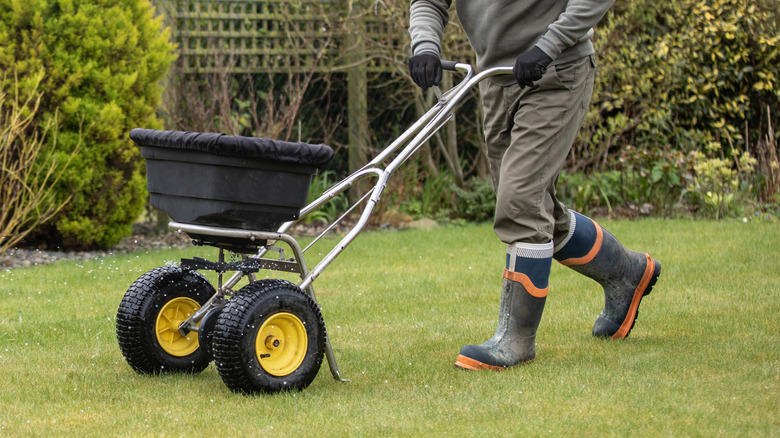The Holiday Fertilization Strategy That'll Give You A Luscious Lawn By Next Spring
We may receive a commission on purchases made from links.
If your holiday traditions include feasting and football, you may want to consider adding a little fertilizing to your festivities. Instead of packing it in for the season, try giving your lawn one last application of fertilizer. It may seem awfully late in the year, but adding nutrition to your grass just before it goes completely dormant helps supplement the soil and will provide a much greener lawn come spring. In many areas of the United States, a good time to do your last fertilization is around Thanksgiving. In fact, it's recommended that you fertilize your yard up to six times a year using holidays as guideposts: Easter, Memorial Day, July 4th, Labor Day, Halloween, and Thanksgiving. Exact dates will vary depending on your climate zone and any weather circumstances specific to your area in a given year.
Fertilizing your lawn adds supplemental nutrients like nitrogen, phosphorus (phosphate), and potassium (potash) — all elements needed for healthy grass. When you apply it late in the year, some of the fertilizer remains available to green up your grass once spring arrives. Other advantages include grass that stays green during the winter even in a state of dormancy, better grass density (thereby reducing weeds) in your lawn, increased drought tolerance, and improved root growth. Cooler temperatures and shorter days actually provide the perfect environment for this last application of fertilizer to be most beneficial.
Which fertilizers are best for fall applications
If you're willing to give late-fall fertilization a try, you don't need to know all about fertilizers, but you'll need to choose the right product to apply to your lawn. Because of the time of year, you'll want a fertilizer that has a very soluble source of nitrogen so that it will quickly make its way into the ground where it can be used to protect the plant. Cooler temperatures slow the rate of growth for blades of grass above ground, but the roots are still actively growing. An organic fertilizer product like fresh manure is not ideal because it's less soluble and won't break down well in the colder temperatures.
Scotts Turf Builder Winterguard is one example of an inorganic fertilizer that works well for a late fall application. The product packaging recommends applying it once all the leaves have fallen. It works on all grass types and can be applied to a wet or dry yard. They do, however, recommend watering the lawn afterwards. If you've already shut off your sprinklers for the year, hand-watering is fine or you can wait for the next rain or snow to do the job for you.
If your area has already experienced a hard frost, adding fertilizer is no longer recommended. Once the live tissue of the grasses has been damaged, it cannot absorb nitrogen. At this point, any fertilizer you spread could blow off the lawn and pollute local waterways. So if Thanksgiving gets the best of you and you've already entered hibernation mode, don't worry. You can always wait until spring to give your grass its next boost.

